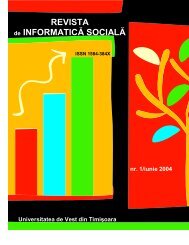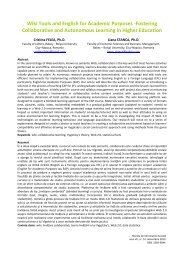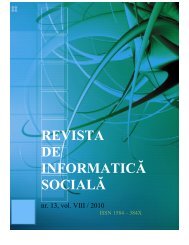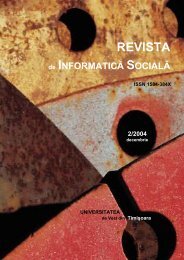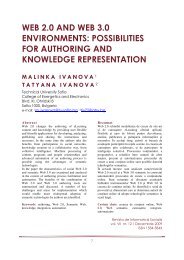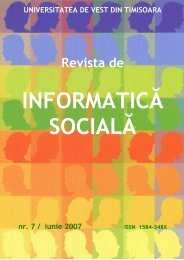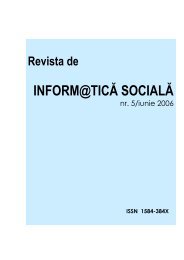Sloan’s emphasis has been on the mainstreaming <strong>of</strong> online learning, rather than on the larger goalsthat institutions must aim for if they are to prosper in the coming economy – namely, thetransformational potential <strong>of</strong> online practices to <strong>de</strong>construct and re-invent educational practices andchange the financial business mo<strong>de</strong>l for higher education. Yet many <strong>of</strong> the market-driven (forpr<strong>of</strong>it)provi<strong>de</strong>rs have followed the suggestions <strong>of</strong> Transforming Higher Education, re-aligning andre-engineering their processes, changing business mo<strong>de</strong>ls, and re-shaping practice. They havebecome the innovative, <strong>de</strong>mand-driven segment <strong>of</strong> the higher education marketplace. It is ourcontention that transformational potential is the real and lasting story about online learning and willbe more wi<strong>de</strong>ly achieved in the future.FOLLOW THE LEADERS AND THE INNOVATORS<strong>No</strong>ne <strong>of</strong> this is truly surprising to anyone familiar with the <strong>de</strong>velopment <strong>of</strong> online and blen<strong>de</strong>dlearning in U.S. higher education. Online and blen<strong>de</strong>d learning are broadly practiced, but are notsufficiently reflected upon, to i<strong>de</strong>ntify and <strong>de</strong>ploy broad-application insights that can lead to truebreakthrough practices. Such transformations can have implications that go far beyond makingsavings at the course-level – including implications for national productivity, competitiveness andfinancial sustainability <strong>of</strong> institutions, job creation for graduates and raising stu<strong>de</strong>nts’employability.Online, Blen<strong>de</strong>d and e-Learning, Broadly PracticedInitially, most institutions use online learning to replicate their courses and curriculum practices inan online mo<strong>de</strong>, making adjustments for the differences between the nature <strong>of</strong> online and face-t<strong>of</strong>aceexperiences. From this initial <strong>de</strong>velopment phase, they progressively improve and enhance theonline experience and discover the power that blen<strong>de</strong>d learning <strong>of</strong>fers, combining online andphysical elements to create more engaging stu<strong>de</strong>nt experiences. Blen<strong>de</strong>d learning has become thepreferred mo<strong>de</strong> for many practitioners, enabling institutions to reduce the need for classroom spaceand to change pedagogical practices. Finally, institutional lea<strong>de</strong>rs incorporate the lessons learnedfrom online and blen<strong>de</strong>d <strong>of</strong>ferings to further enhance all face-to-face instruction with technologyresources and techniques that work. As a result, the balance shifts from face-to-face instruction to“e-learning.” Institutional lea<strong>de</strong>rs leverage this range <strong>of</strong> technology-supported learning <strong>of</strong>ferings toimprove the efficiency and effectiveness <strong>of</strong> their <strong>of</strong>ferings and to provi<strong>de</strong> learners with a portfolio<strong>of</strong> choices. Offering a range <strong>of</strong> instructional choices is especially attractive to adult learners andstu<strong>de</strong>nts who are working (the most recent data from our key clients suggests that greater than 70%<strong>of</strong> full-time enrolled stu<strong>de</strong>nts are working at least part-time).Breakthroughs by Market Lea<strong>de</strong>rsUnlike emerging practice elsewhere in the world, the majority <strong>of</strong> U.S. practitioners have notattempted systematically and systemically to think about themselves as participants in a globalKnowledge Society. <strong>No</strong>r have they i<strong>de</strong>ntified which parts <strong>of</strong> their activities rely on knowledge towhich competitors also have access; which parts rely on internally-created knowledge; and in whatways they use that knowledge to create outcomes valued by their various audiences. Theseperspectives are necessary to i<strong>de</strong>ntify ways to unbundle learning, assessment, and certification andre-invent faculty roles. <strong>No</strong>r have they attempted to fundamentally change the business mo<strong>de</strong>l orprice points for learning. For these reasons, looking at the total U.S. population <strong>of</strong> online learningpractitioners is less instructive than un<strong>de</strong>rstanding the global lea<strong>de</strong>rs and extrapolating theirinnovations into the future, to highlight effects on U.S. competitiveness.By examining the breakthroughs achieved in online learning by today’s current or emerging marketlea<strong>de</strong>rs, both in the US and abroad, we can better un<strong>de</strong>rstand the real story about the potential future<strong>of</strong> technology-supported learning in all its settings and permutations. In this paper, we use thebehavior <strong>of</strong> market lea<strong>de</strong>rs and trend-setters to sketch the likely evolutionary paths <strong>of</strong> online
learning. We also <strong>de</strong>scribe how the vast number <strong>of</strong> mainstream practitioners can positionthemselves to take advantage <strong>of</strong> this evolution and for success while others, less well-prepared, facethe withering competition to come.WHY HAS ONLINE LEARNING BECOME EVEN MORE STRATEGIC?Up to this point in its <strong>de</strong>velopment, online learning has been waging a battle <strong>of</strong> acceptance withfaculty, institutional lea<strong>de</strong>rs, and some stu<strong>de</strong>nts. Yet research has shown that online learning hasprogressively come to be regar<strong>de</strong>d as equivalent or even superior in some ways to traditional, faceto-facelearning, especially among 18- to 24-year-old and working adult learners and faculty whowere early adopters.The so-called Great Recession and the American Higher Education Affordability Crisis have raisedthe stakes for online learning not just in the US, but globally. The predictions voiced inTransforming Higher Education and “How to Think about Rising College Costs” have sadly cometo pass: we cannot afford mass higher education using existing mo<strong>de</strong>ls, and stu<strong>de</strong>nts who takecourses built on those mo<strong>de</strong>ls seem at increasing risk <strong>of</strong> gaining outmo<strong>de</strong>d and low-value skills, sowill not earn enough to repay their stu<strong>de</strong>nt loans. Transformed versions <strong>of</strong> online, blen<strong>de</strong>d and e-learning hold the potential to be essential elements <strong>of</strong> the re-imagining <strong>of</strong> American highereducation, post recession, to make it more relevant to societal needs, sustainable worldwi<strong>de</strong> andfinancially worthwhile for stu<strong>de</strong>nts too. Four factors make this so.Addressing the American Affordability CrisisLearners and parents are facing an affordability crisis <strong>of</strong> unprece<strong>de</strong>nted propositions. In America,the cumulative effect <strong>of</strong> year-after-year escalating costs <strong>of</strong> tuition has outstripped the rate <strong>of</strong>inflation for 30 years running. Gradually American higher education is becoming a pricey if notunattainable proposition for many potential learners. The current recession, rising unemploymentand collapse <strong>of</strong> the housing market have reduced the net worth <strong>of</strong> families and changed theeducational plans <strong>of</strong> many learners.Community colleges and for-pr<strong>of</strong>it educational provi<strong>de</strong>rs have experienced explosive growth in<strong>de</strong>mand in 2009-2010 as learners turn to more convenient, local, high-value, alternatives to midrankingpublic four-year institutions and private colleges. Some community colleges in especiallystrapped states like California have turned away legions <strong>of</strong> stu<strong>de</strong>nts this year. Truly transformedlearning, using combinations <strong>of</strong> online, blen<strong>de</strong>d, and e-learning, has the potential to mo<strong>de</strong>rnizecourse content cheaply and reduce the total cost <strong>of</strong> achieving competence objectives. They alsocould improve the economic prospects <strong>of</strong> learners by providing a range and mix <strong>of</strong> options thatmeet their personal and financial needs.The pages <strong>of</strong> The Chronicle <strong>of</strong> Higher Education and Insi<strong>de</strong> Higher Education are peppered withstories <strong>of</strong> community colleges, in particular, whose lea<strong>de</strong>rs are experimenting with increasinglytransformative mixtures <strong>of</strong> solutions to these challenges.Achieving Financial Sustainability Requires TransformationThe mo<strong>de</strong>l for funding public institutions is broken, as has been reflected in the diminishing relativelevel <strong>of</strong> public support for education in general over the past three <strong>de</strong>ca<strong>de</strong>s. Community collegesand other public four-year institutions typically experience their greatest enrollment <strong>de</strong>mand at atime when state and local resources <strong>de</strong>cline and jobs for college leavers are har<strong>de</strong>st to find.Transformed learning can change the business mo<strong>de</strong>l so that the marginal cost <strong>of</strong> learning isconsistently reduced to less than the price <strong>of</strong> tuition, allowing growth to meet <strong>de</strong>mand, even duringrecession. Market lea<strong>de</strong>rs have already achieved this goal. This transformed learning must bematched by transformed content, suited to changes in the wi<strong>de</strong>r economy. In particular, contentmust do more to help stu<strong>de</strong>nts to apply what they learn (to bridge the “knowledge-action gap”), so
- Page 1: Revista de Informatica Sociala 14 /
- Page 7: ● ● ●CONTENTS● ● ●[9-20
- Page 10 and 11: THE TRANSITION FROM OLD TO NEW MEDI
- Page 12 and 13: 30252023.420.325.11510500.85.5Never
- Page 14 and 15: Overall, we can therefore sum up on
- Page 16 and 17: n.a.I often use itI seldom use it6.
- Page 18 and 19: - Traditional web use: searching th
- Page 20 and 21: 19. Kvavik R.B., Caruso J.B. and Mo
- Page 22: IntroductionIn 1995, Bernie Dodge o
- Page 25 and 26: The Web-Inquiry Project [WIP] is a
- Page 27 and 28: and even orally. The teacher will a
- Page 29 and 30: environment in which the teacher gu
- Page 31 and 32: Transformation Through Online Learn
- Page 33: INTRODUCTIONLeading practitioners a
- Page 37 and 38: Some of these transformations are b
- Page 39 and 40: Recently, Twigg has received suppor
- Page 41 and 42: Stage III: Unbundled Learning, Mark
- Page 43 and 44: perhaps using Second Life-like virt
- Page 45 and 46: performance. Indeed, Stage V will l
- Page 47 and 48: Free-Range Open LearningOver time,
- Page 49 and 50: New communities, tools and services
- Page 51 and 52: Embed enterprise-wide predictive an
- Page 53 and 54: In collaboration with Strategic Ini
- Page 55 and 56: Wiki Tools and English for Academic
- Page 57 and 58: eality. Besides being an additional
- Page 59 and 60: StudentPage 1StudentPage nTeacher
- Page 61 and 62: 100%90%80%70%60%50%40%30%20%10%0%Ac
- Page 63 and 64: 200Correlation View/Page Edits150Vi
- Page 65 and 66: 14. http://eacea.ec.europa.eu/llp/s
- Page 67 and 68: Simularea şi comunicarea electroni
- Page 69 and 70: RespondenţiRăspunsuriLa nivelul
- Page 71 and 72: RespondenţiRăspunsuriLa nivelul
- Page 73 and 74: Respondenţii au fost rugaţi să i
- Page 75 and 76: Itemul 9 doreşte să identifice ti
- Page 77 and 78: Identificara opţiunii, chiar şi p
- Page 79 and 80: EşantioaneRăspunsuri/Ranguriagita
- Page 81 and 82: modalităţile practice prin care u
- Page 83 and 84: 1. INTRODUCEREÎn prezent, complexi
- Page 85 and 86:
Figura 1. Analiza grafică a evolu
- Page 87 and 88:
Faţă de această situaţie se deg
- Page 89 and 90:
variabilele acesti noi culturi cybe
- Page 91 and 92:
INTRODUCEREÎncă din anul 2000 am
- Page 93 and 94:
după tipul lecţiei: prezentare de
- Page 95 and 96:
Funcţiile oferite de AEL asigură
- Page 97 and 98:
• elevi/studenţi, beneficiari di
- Page 99 and 100:
Se poate folosi cadrul formal de co
- Page 102 and 103:
Evaluarea formativă este comentari
- Page 104 and 105:
Rezultatele elevilor, pe itemi:Diag
- Page 106 and 107:
Nr. Denumirea activităţii AEL MOO
- Page 108 and 109:
SEMNAL EDITORIALLaura MALITA, Vanna
- Page 110:
IN MEMORIAMConstantin TraianCHEVERE




